With his current deal set to expire in the summer, Barcelona and LaLiga are facing the prospect of losing Lionel Messi once that happens. With all the recent turmoil surrounding the Argentine, it wouldn’t be a surprise to truly see him leave but it would put the Blaugrana in a tricky situation.
Barcelona are much stronger when Messi is in the team, that much we can say with relative certainty. However, recently, Elche’s coach Jorge Almirón stated the Catalans look like a more structured team when Leo is not in the squad. While this doesn’t necessarily mean they’re a better team without him, it does force an interesting narrative. How do Barcelona look without their little genius?
This tactical analysis will attempt to analyse the games they have played without him this season and decipher whether there are any differences in their tactics. The analysis of this scout report will also include statistical parts that will help us highlight those aforementioned differences.
Let’s dive straight into it.
Statistical and structural overview
Before delving deeper into the tactical analysis, we have to explain the sample we’re working with here. Messi has played a total of 24 games across all competitions at the moment of writing, scoring 16 goals and assisting further six on the side. This means that he was absent for six games in 2020/21, limiting our pool to a rather low figure but still enough of a sample to base our analysis on.
540 minutes without Messi is quite a lot of time and Barcelona have had mixed results in that period. Of course, another thing to note is that he wasn’t absent for 540 minutes in a row but rather, scattered across the season. This is important because Ronald Koeman’s tactics have evolved since the beginning of the campaign so our main focus will be on the latest clashes without the Argentine in the squad.
Still, to even out the playing field, I’ve calculated the average stats for Barcelona with Messi in the team and then, since the difference in the number of games is big, I’ve also decided to calculate the averages for the last six games with and without him. You can see the dashboard with the data down below.
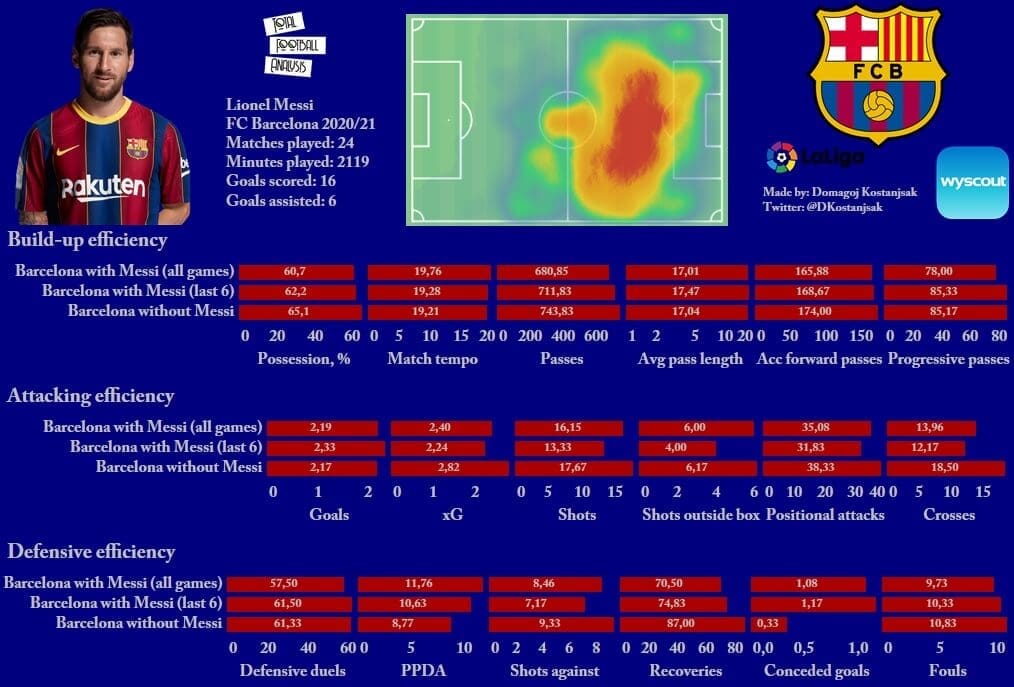
Before making any big conclusions based on the statistics, it should also be pointed out the level of the opposition wasn’t taken into account here. Naturally, Barcelona will have an easier job beating some teams and then struggle with others. For instance, they’ve tallied a 4-0 victory over Dynamo Kyiv and have beaten Ferencváros 3-0 in the Champions League without him.
These two games specifically may have inflated the stats a bit but shouldn’t distort the overall image too much. Looking at the stats, we can see some interesting things. For instance, Barcelona without Messi seem to be a far more dynamic team, registering higher possession with a slightly more vertical approach. The tempo of their play is more or less the same but they seem to create more chances, register more shots and more positional attacks on average.
Interestingly, however, Messi’s decisiveness means that despite creating less and shooting less, they still score more goals with him in the team. They also rely less on crosses in general, which could be a side-effect of a far more central approach, which we’ll discuss later in this tactical analysis.
Defensively, Barcelona look more efficient without him, which isn’t that big of a surprise given his lack of duties in that phase in general. With lower PPDA (passes allowed per defensive action), more recoveries and far fewer goals conceded, the Catalans do seem to defend better without him.
However, somehow they’ve also registered more shots conceded and attempted more fouls, which is due to more aggressive defensive tactics in general. Finally, let’s look at some main structural differences before dissecting them a bit further.
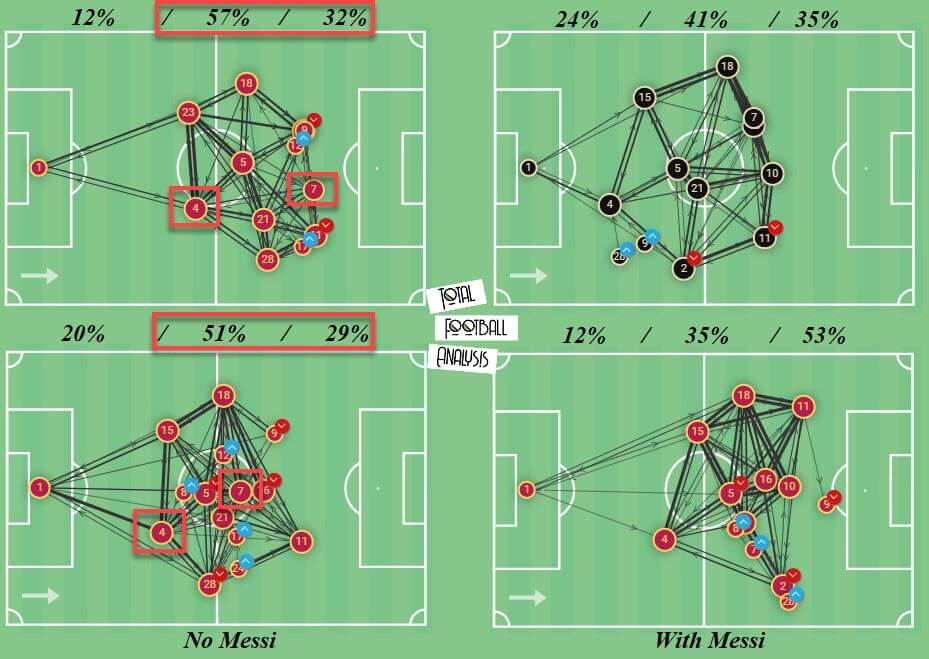
Above are four pass maps with two being with and two without Messi in the team. I’ve highlighted some of the main differences that can be seen from the graphs. Firstly, let’s look at the team shape and the change in roles. Antoine Griezmann’s positioning is very interesting because it seems like the former Atletico Madrid star is given Messi’s role whenever the Argentine is not around.
Looking at his positioning in both of the games on the left, it’s clear it mimics Messi’s positioning on the right. Griezmann will have a more central role and will drop deeper when necessary, just as Leo does when he’s around. Similarly, we can see the difference with the positioning of the right centre-back, in this case Ronald Araújo.
When Messi is playing, Araújo seems to be far deeper on the pitch. This could be for defensive cover, seeing how Messi likes to cut inside onto his left foot, leaving the flank free and prompting the right-back to overlap if there is no natural winger on that side. This, however, can lead to a lot of space to be exploited by the opposition, making the right centre-back take a more defensive approach.
Without Messi and the team more balanced structurally, the right centre-back is given more freedom in his movement. A similar thing can be said for the right-back but that mostly depends on whether a winger is playing or not, as we’ve already alluded to earlier.
And finally, it does seem like Barcelona often spend more time in the middle third of the pitch when Messi is not there as opposed to the final third when he is. This does make sense as he’s usually the one to get them there when they run into progression problems. Without him, the onus is on the midfield more than it usually is and this does lead nicely into higher possession values and more passes in general. I’ve deliberately used one of the games with him where that isn’t the case because the structure perfectly mirrored the one on the left and to highlight that this isn’t something that’s always set in stone.
This tactical analysis will now shift towards dissecting some of the main points we’ve mentioned earlier.
Griezmann in the ‘Messi role’
The fact that Griezmann and Messi share some similarities is nothing particularly new. The Frenchman also enjoys a free role in the team and likes the play to flow through him in attack. However, when Messi is on the pitch, that becomes very difficult.
But as we’ve seen from the previous graph in the earlier section of this tactical analysis, without Messi, Koeman often gives Griezmann the Argentine’s role. Let’s first explore their respective heatmaps for more insight.
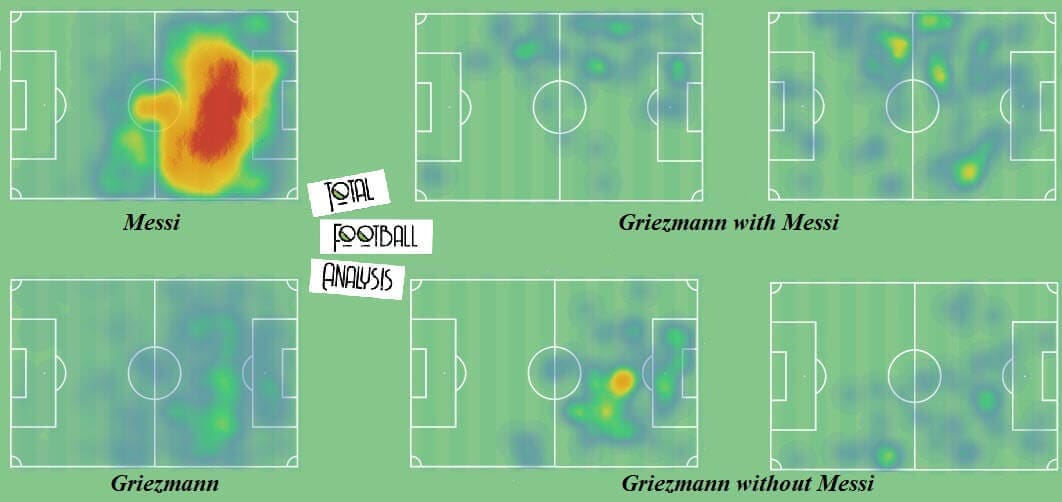
With Messi on the pitch, Griezmann is instantly relegated to the wide areas a lot more. While that is not necessarily a completely unfamiliar role for the Frenchman, it can be limiting. Without Messi, however, we can see him in the central areas far more and at the very least, occupying the right half-space as well as the deeper areas on that side.
Being a left-footer who likes to cut inside, not unlike Messi, the inverted forward role on the right side plays to his strengths much more. We can also see the similarities in their respective approaches as Griezmann affects the build-up phase with his tendency to drop deep and keeps the structure symmetrical with the wide positioning.
Before moving on to some in-game example of how this is done when Messi is not playing, let’s quickly see Griezmann’s dashboard compared to other LaLiga strikers. Note that the data used is only for the domestic league with other competitions excluded.
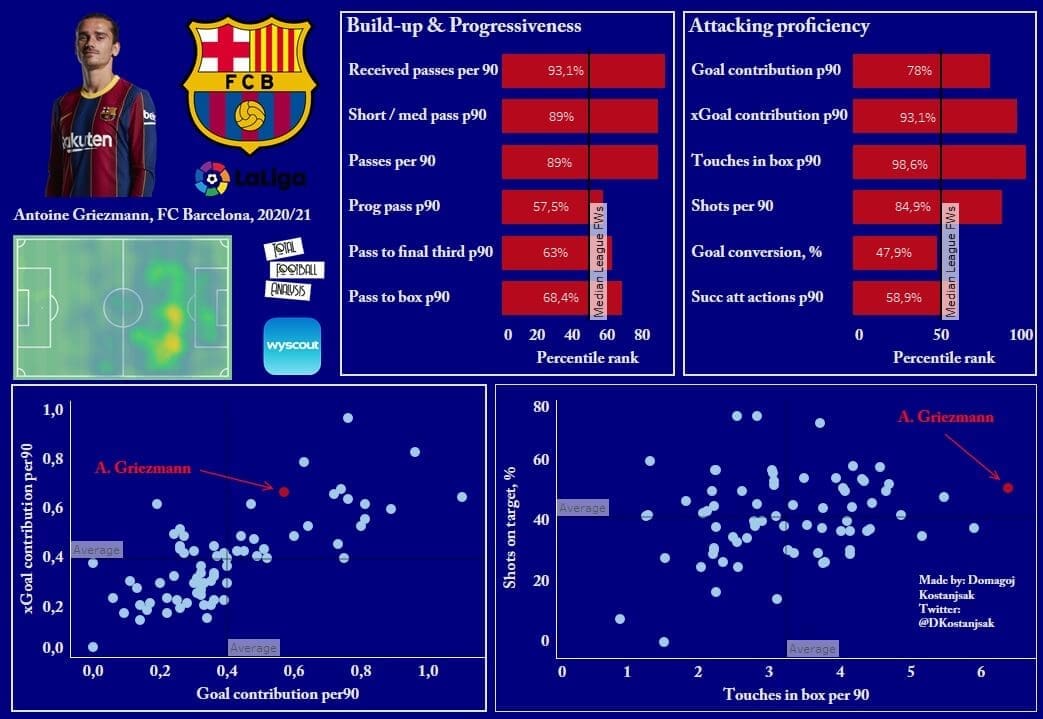
What’s particularly interesting is the data concerning the build-up phase and progression. Griezmann is one of the most involved strikers in the league despite often getting criticised for being too invisible. Just the fact that he’s in the top 7% in received passes and top 11% in overall passes per90 is further proof of his involvement.
As a finisher, however, he should be doing far more than he currently is. His expected goal contribution is higher than his real goal contribution, which can be attributed to below-par conversion. Still, with a high number of touches in the box, shots and overall successful attacking actions, Griezmann is turning into the player Barcelona need.
But how does he function when Messi is not around?
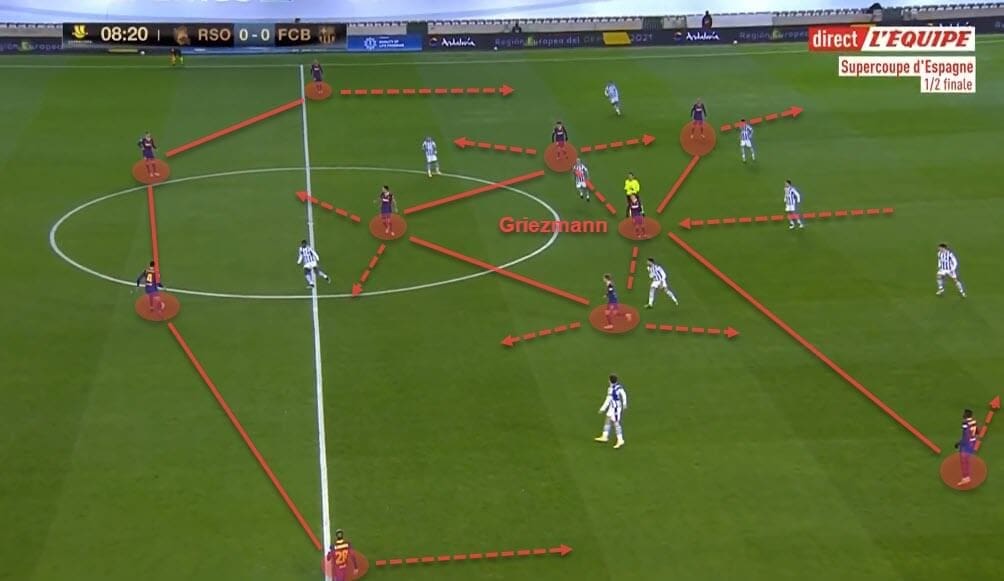
The pass maps we saw earlier in this tactical analysis have already given us a template to look for. Above is also an image from the clash against Real Sociedad where Messi was absent. Even though Koeman’s structure without the Argentine differs, this example in particular gives us a clear picture of what the system looks like in general.
Notice how Griezmann will drop deeper into the false nine or the no.10 role at the tip of the diamond formed with the midfield trident. With this particular movement, Barcelona can create a central overload given their usual preference for those channels as opposed to the wider ones. Similarly, his movement towards the deeper areas affects the movement of the midfielders.
Both Frenkie de Jong and Pedri, who are the usual no.8s within the system, will often take up a much more advanced position because of Griezmann’s movement. The similar thing happens with Messi so, in this regard, Barcelona are mostly changing the personnel rather than the structure and tactics. But there is more than initially meets the eye and we’ll touch upon it further down the line of this tactical analysis.
With Griezmann in a much deeper role, he can influence play and become the distributor of the team. You can see a good example of that in the image below.
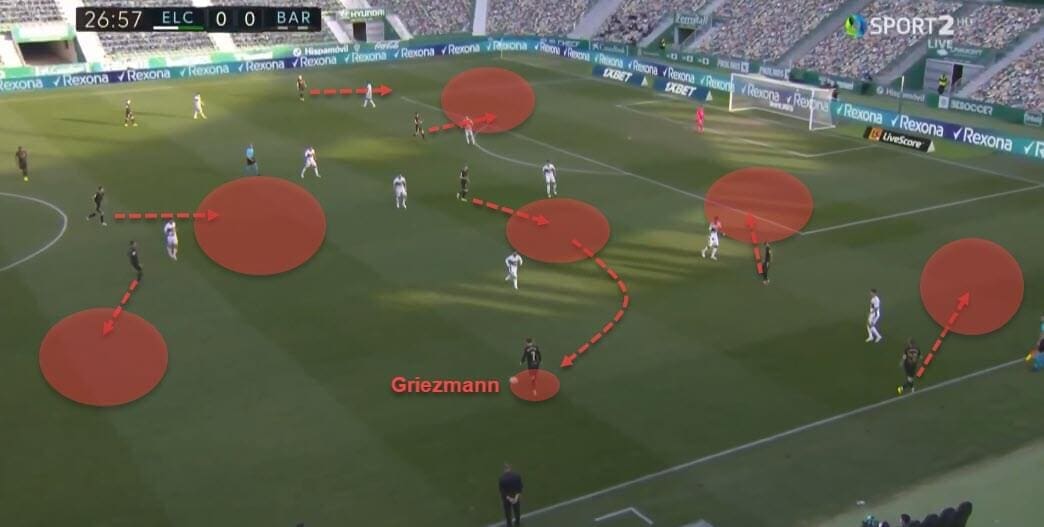
But what this example also does is emphasise the whole structure of the team. Griezmann is the team’s striker, yes, but with that free role he gets and the opportunity to use the width of the pitch more effectively without Messi, Barcelona can successfully occupy all five of the main channels in attack.
Notice the positioning and space occupation of the forward line as well as the channels they can exploit behind the opposition’s defence. That is not to say this kind of a structure is never replicated with Messi on the pitch but his tendency to be everywhere and roam freely usually breaks the main principles of space occupation in any system, the Catalans’ 4-3-3 included.
The Argentine’s gravity is also that strong that it immediately attracts multiple markers, which Barcelona can use to their advantage. However, the same can be said for his teammates, all of whom are drawn to him as soon as the opportunity presents itself. This can make their attack predictable and very linear, sometimes even resulting in fewer chances created and fewer positional attacks attempted per game, as we’ve seen the stats confirm as well.
Griezmann may not have the same pulling power as Messi but his movement also creates opportunities for Barcelona. You can see the channel he will mostly use to drop deeper when the Argentine is not on the pitch.
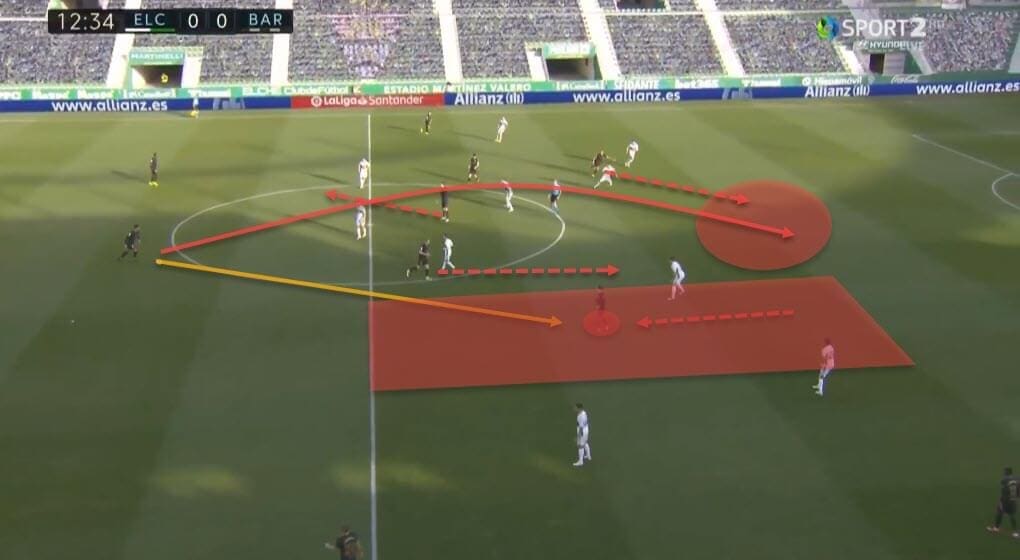
The Frenchman will use the right half-space to open a new passing channel for the backline and use that to progress the play. This is also an instant cue for the midfielders, usually De Jong, to swap places with him. It’s a similar principle we’ve seen with Arturo Vidal and Messi interchanging positions while the Chilean was still at the club before his move to Serie A.
Again, the pitch is fully stretched and space starts to open up as Griezmann drags the defenders away from their position. But it’s this tendency to optimise space occupation and offer a different approach that may be the biggest takeaway here and that’s exactly what we’ll explore more in the next and final section of this tactical analysis.
Space occupation and alternate attacking approach
We’ve already mentioned how Messi’s freedom can affect the whole structure and we’ll delve a bit deeper into that here. The Argentine is very dynamic in his movement and space occupation and while that allows him to influence play across the pitch, the sheer lack of positional rigidness often means Barcelona become one-dimensional.
Once again we come back to the gravity that was alluded to earlier. A good player can use his movement to attract the opposition, drag them out of their structure and create space that way. Messi does this on a whole different level as his presence alarms multiple markers at once but it’s also a beacon for his teammates.
Let’s compare that in a couple of graphs below.
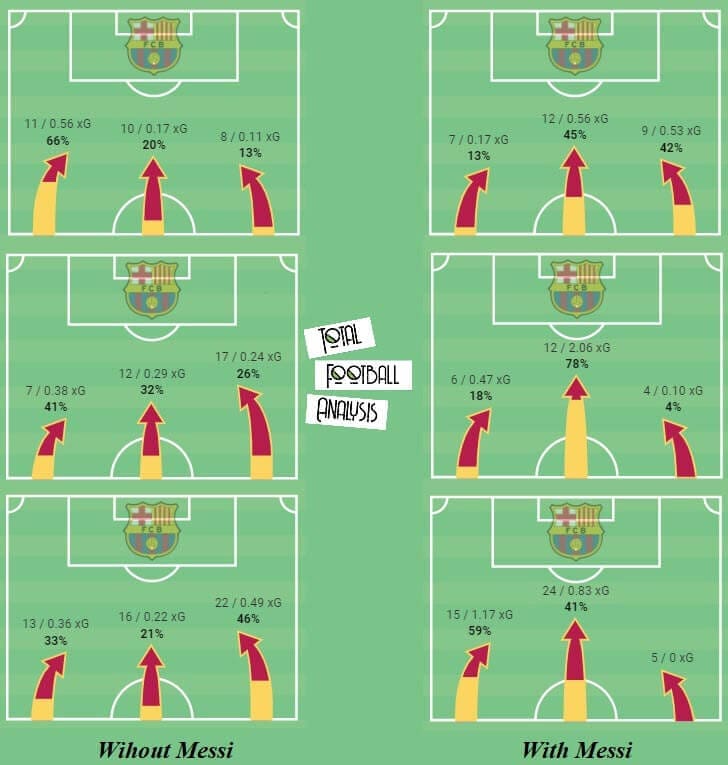
On the right, we have three games with Messi and on the left, we have three without him. What stands out in the games on the right is how central Barcelona are with the Argentine. This is due to him cutting in from the right side and then consistently being found by his teammates, even when it doesn’t serve a greater purpose of advancing the attack.
Of course, he is the ultimate difference-maker, that much we know, but this tendency often breaks the ‘structure’ of the team. Another reason why that is so is due to his preference to come short to receive the pass instead of keeping his position or running into space.
And usually he will come a few steps away from the ball-carrier to take the ball, which is far from ideal. An even bigger problem could be the fact that with him on the pitch, Barcelona often have too many players with the same tendency.
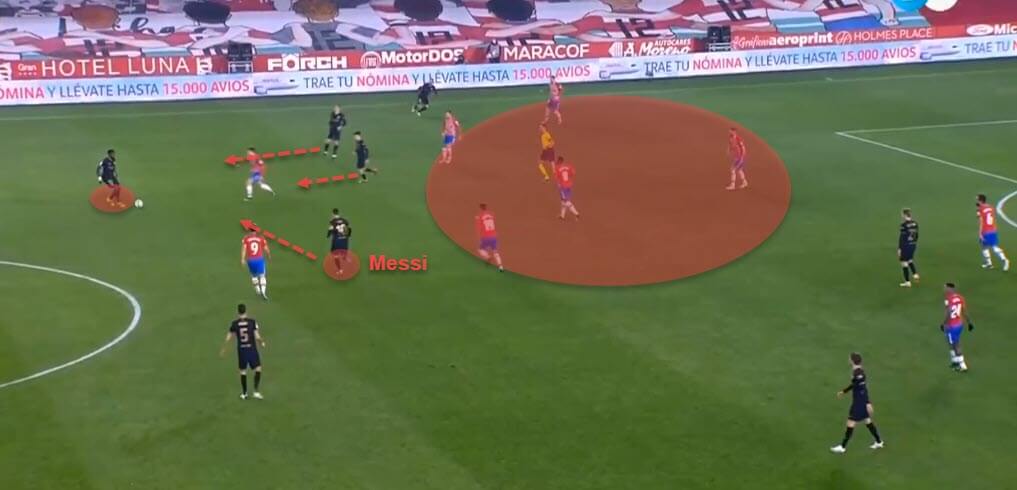
Above, you can see all three of Messi, Griezmann and Pedri come short, resulting in Barcelona’s half-space occupation to be subpar at best. Yes, the wide player, whether that be a winger or a full-back, can charge behind the opposition’s line but he’s heavily outnumbered to begin with.
Messi wants the ball at all times and while it’s difficult not to give him possession since, chances are, he’ll do something good with it, the free roam role can harm their overall structure, which is what Elche’s coach might’ve meant back when he made that statement.
The example below shows us another instance of Barcelona’s poor space occupation following Messi abandoning his position. Yes, he offers Sergi Roberto a new channel to exploit but the Catalans sacrifice a clear presence down the middle because of it.
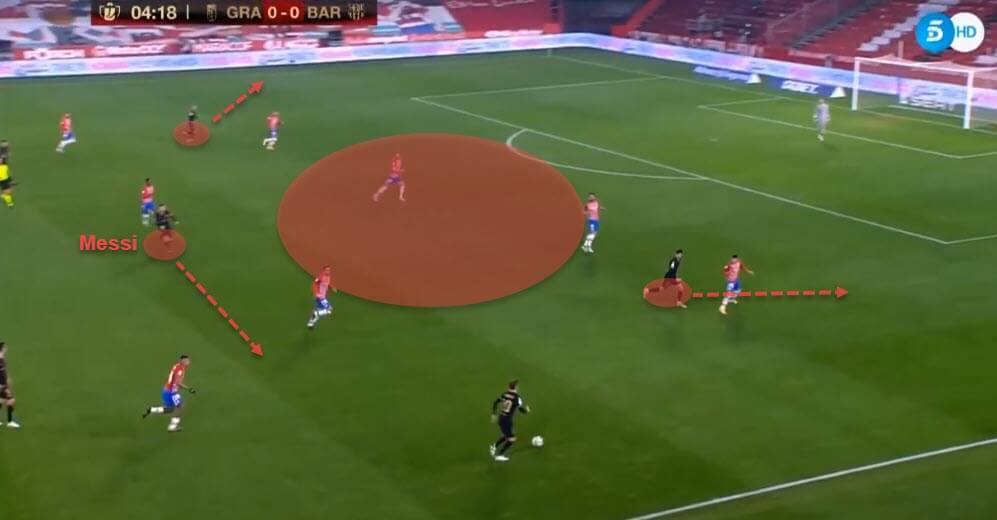
Unfortunately, this is not an isolated case either. If Barcelona play with a winger and Messi at the same time, it means he gets the central role. But due to him dropping so deep to progress the play and take possession in the middle or even the first third, the midfielders are often forced to take his position.
However, when that doesn’t happen either due to a lack of a fitting profile or simply bad structure on the pitch, the team suffers as a result. Take the game against Athletic Club below as an example. Messi is the ‘striker’ in this instance, at least on paper, while Griezmann is the left-winger and Ousmane Dembélé is on the right.
The midfield consists of Pedri, Miralem Pjanić and De Jong with the Dutchman playing as the deep playmaker, dropping the deepest on the pitch.
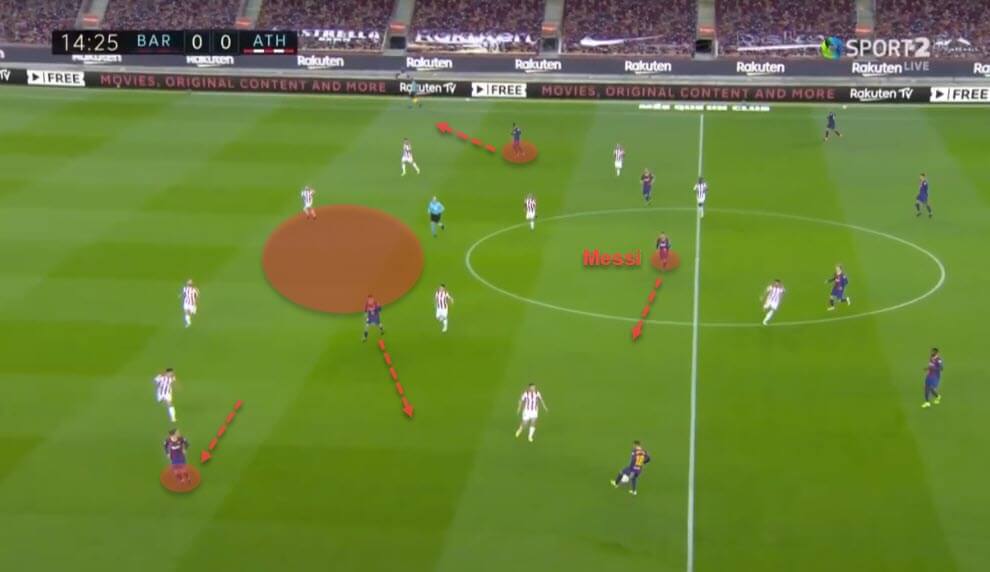
Since the former Ajax talent is between the centre-backs, he can’t take up Messi’s position higher up the pitch. Pedri, as we’ve already concluded, likes to come short for the ball and he does exactly that here. Pjanić, however, won’t make the same run De Jong would make in his place and Messi again drops deeper.
This leaves Barcelona with less than ideal space occupation and once again lacking a clear presence down the middle channels to pin the centre-backs or offer runs behind the defensive line.
Compare that to the attacking structure without him and you can see the results are quite different. In the following image, once again we have five members joining the attack and here, granted, Pedri himself comes short as he usually does but the structure remains solid.
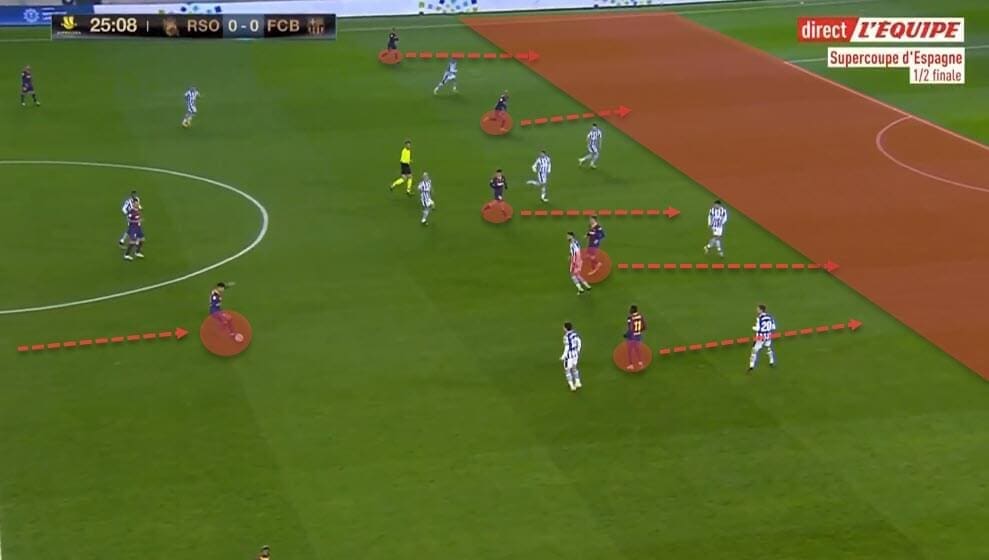
Final remarks
So what can we conclude following this thorough tactical analysis of Barcelona with and without Messi? People often confuse structure with being symmetrical, which isn’t the case. Asymmetrical systems are still very valid but the Argentine often has no defined position on the pitch and that can definitely disrupt the team’s space occupation.
He may act more as a no.10 or a false nine but confining him in those two boxes would also be doing him a big disservice. But it’s his decisiveness and lethality that still makes up for the lack of a structure.
So are Barcelona more structured without him then? Probably so but that doesn’t necessarily translate to them being a better team overall. That, however, is an analysis for another time.






Comments